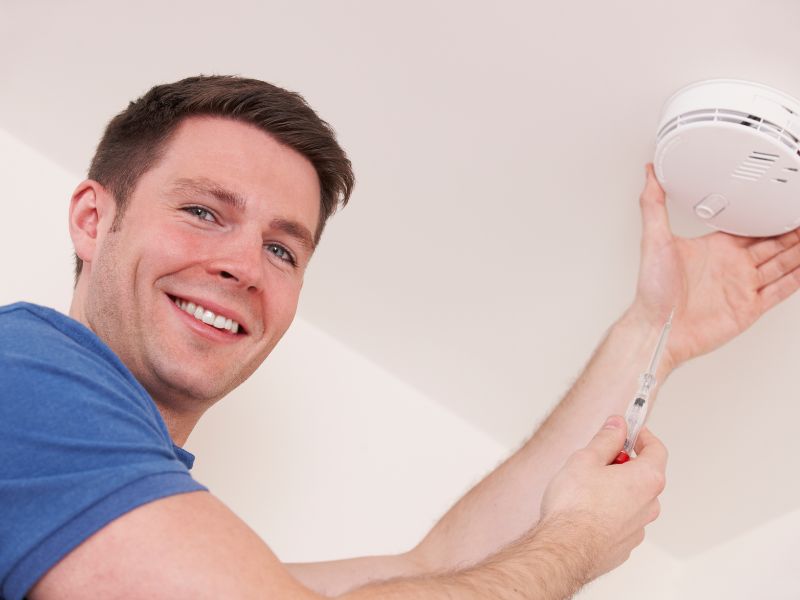Carbon monoxide is a hazardous gas that can claim lives within a short period of time. Sources of the gas are many, including furnaces, gas stoves, and generators. But, did you know that carbon monoxide detectors have limitations? Specifically, they have a certain range within which they can detect gas in the atmosphere. The question is, how far should carbon monoxide detectors be from furnaces so that they can be effective? In this article, we will explore that question, look at the reasons behind it, and provide you with practical tips on keeping your home safe from carbon monoxide poisoning.
Tabe of Contents
- 1. Understanding the importance of placing a carbon monoxide detector near a furnace
- 2. Factors to consider when determining the placement of a carbon monoxide detector
- 3. Recommended distance between a furnace and a carbon monoxide detector
- 4. Placement of a carbon monoxide detector in multi-level homes with multiple furnaces
- 5. How to test the effectiveness of carbon monoxide detectors near a furnace
- People Also Ask
- Conclusion
1. Understanding the importance of placing a carbon monoxide detector near a furnace
Carbon monoxide (CO) is an odorless, colorless, and tasteless gas that can cause serious health problems, including death. Furnaces, gas-powered appliances, and vehicles are some of the potential sources of CO buildup in homes. Therefore, installing a carbon monoxide detector in areas near these sources is crucial to safeguarding the health and well-being of occupants. In this article, we will discuss the importance of placing a carbon monoxide detector near a furnace to keep you and your loved ones safe.
When fuel burns in a furnace, it produces carbon monoxide, which can easily seep through walls and ventilation systems. Furthermore, furnaces that are old or have not been maintained properly can malfunction, leading to CO buildup in the home. Without a carbon monoxide detector near the furnace, an accumulation of this gas can go undetected until it reaches a dangerous level.
Carbon monoxide poisoning can cause flu-like symptoms such as nausea, headache, dizziness, and confusion. Prolonged exposure can lead to unconsciousness, brain damage, and even death. The importance of having a carbon monoxide detector in proximity to the furnace cannot be overstated, as it provides an early warning system in the event of CO buildup.
In the following sections, we will discuss the recommended placement of a carbon monoxide detector near a furnace, factors to consider when determining the placement, and how to test the effectiveness of carbon monoxide detectors in homes. By , you are taking a critical step in ensuring the safety of your home and family.
2. Factors to consider when determining the placement of a carbon monoxide detector
When it comes to choosing the right location for your carbon monoxide detector, there are several factors to consider. The placement of the device plays a crucial role in its effectiveness in detecting CO gas leaks. Here are some factors you need to keep in mind:
Proximity to the Furnace
Carbon monoxide is produced when fuels such as natural gas, wood, coal, or propane are burned. As such, furnaces are one of the primary sources of carbon monoxide gas in houses. Therefore, it’s crucial to place the carbon monoxide detector as close to the furnace as possible. This ensures that the monitor detects any CO gas produced from burning fuels before it spreads to other areas in the house.
Ventilation
Carbon monoxide gas is denser than air and can accumulate inside your home. However, proper ventilation can help keep CO gas levels low. If your furnace is installed in an unventilated area, you need to consider placing your CO detector near an air vent or window to ensure that the device monitors the air quality properly.
Interference
CO detectors should not be exposed to high humidity, direct sunlight, or heat, as this could interfere with their sensor’s ability to detect carbon monoxide. Therefore, you need to avoid placing the device near high-temperature areas like heating ducts, humidifiers, or water heaters. You should also keep the detector away from windows, doors, or other sources of airflow.
When considering the placement of your carbon monoxide detector, it’s vital to keep these factors in mind. Remember, a correctly placed detector ensures that you and your family are safe from carbon monoxide poisoning.
3. Recommended distance between a furnace and a carbon monoxide detector
It is crucial to place a carbon monoxide detector near a furnace to prevent any harmful gas from entering your home. However, the question remains: how far should the detector be from the furnace? The answer lies in various factors that homeowners should consider before installing a carbon monoxide detector.
Firstly, the distance of the detector from the furnace is crucial to ensure it detects any concentration of gas immediately. As per the National Fire Protection Association (NFPA), homeowners should place a carbon monoxide detector within ten feet of the furnace. The detector should also be installed on the ceiling or high on a wall close to the furnace.
Additionally, other factors that can determine the placement of the carbon monoxide detector include the size of the furnace, ventilation in place, and the type of fuel used. If a furnace has open combustion, it produces more carbon monoxide than a furnace with sealed combustion. Therefore, a detector should be placed closer to furnaces with open combustion than sealed combustion. Moreover, homes with inadequate ventilation can quickly accumulate carbon monoxide gas and require more than one detector for maximum safety.
Ultimately, homeowners must ensure that they follow the manufacturer’s instructions and any relevant safety codes when installing carbon monoxide detectors. It is essential to place the detector in an area where it is less likely to be covered by furniture or curtains and ensure it is audible from sleeping areas. This will ensure you and your loved ones are protected from the dangers of carbon monoxide.
4. Placement of a carbon monoxide detector in multi-level homes with multiple furnaces
It is important to have a carbon monoxide detector installed in every level of a home with multiple furnaces. This is because each furnace has the potential to produce carbon monoxide gas, and having multiple furnaces means there are more sources of the gas. Therefore, installing detectors on every level can help detect the presence of the gas and prevent possible harm.
When deciding where to place the carbon monoxide detector in each level, it is important to consider the distance and location of each furnace. For example, if a furnace is located in the basement, it is recommended to install a detector nearby. If there is a furnace on the upper level of the home, another detector should be placed near that furnace.
In addition, it is important to avoid installing carbon monoxide detectors near windows, doors, or HVAC vents, as this may affect the effectiveness of the detector. Instead, install detectors at least 15 feet away from fuel-burning appliances and furnaces, but not too far as to be ineffective.
Overall, the placement of carbon monoxide detectors in multi-level homes with multiple furnaces is crucial in ensuring the safety of the occupants. Proper placement can help detect the presence of carbon monoxide gas, and installing detectors on every level can help prevent possible harm.
5. How to test the effectiveness of carbon monoxide detectors near a furnace
Testing the effectiveness of carbon monoxide detectors near a furnace is crucial for ensuring the safety of your home and family. Carbon monoxide is a silent killer that can go undetected without the proper precautions in place. Performing a simple test is an easy way to make sure your detectors are working properly and keeping you safe.
Step 1: Choose the Right Test
The first step in testing your carbon monoxide detectors is to select the proper test. There are two main types of tests you can perform: the “test” button on the detector and the professional-grade “canned CO” test. The test button on the detector only checks the battery and alarm function, while the canned CO test actually simulates carbon monoxide to ensure the detector is working properly.
Step 2: Prepare the Environment
Before testing your detectors, make sure to prepare the environment. Turn off all appliances that emit gas or flammable vapors, such as your stove or gas furnace. Make sure all windows and doors are closed, and no one is in the room for the duration of the test. This will prevent false alarms and ensure an accurate reading.
Step 3: Test the Detectors
To perform the test, follow the instructions on the test kit or press the “test” button on your detector for a few seconds. If the detector is working properly, it should emit a loud, continuous alarm. If the alarm is quiet or nonexistent, replace the batteries or the entire detector if necessary.
Testing your carbon monoxide detectors on a regular basis is essential for keeping your home safe from this deadly gas. Remember to always follow manufacturer instructions and replace your detectors every five to seven years to ensure maximum effectiveness.
People Also Ask
Can you put a carbon monoxide detector near a furnace?
Yes, you can put a carbon monoxide detector near a furnace. In fact, it is recommended that at least one detector be placed within 10 feet of the furnace for early detection of any potential leaks.
How far should a CO detector be from a gas water heater?
A carbon monoxide detector should be installed within 10 feet of a gas water heater to detect any potential leaks.
Where should a carbon monoxide detector be placed in a two-story home?
In a two-story home, a carbon monoxide detector should be placed on each level of the home, including the basement. The detector should be placed near any fuel-burning appliance or in a central location for maximum coverage.
Can carbon monoxide detectors be too close to each other?
Carbon monoxide detectors can be placed in close proximity to one another. However, it is recommended that they be installed at least 15 feet away from potential sources of carbon monoxide, such as fuel-burning appliances, to prevent false alarms.
What happens if a CO detector is too close to a gas furnace?
If a carbon monoxide detector is too close to a gas furnace, it may produce false alarms due to the regular combustion process of the furnace. This can result in unnecessary panic and disruption.
Conclusion
To ensure the safety of your home, it is important to install carbon monoxide detectors in the right location. A detector should be placed within 10 feet of the furnace, gas water heater, or any other fuel-burning appliance to detect any potential leaks. In a two-story home, a detector should be installed on each level. While detectors can be placed in close proximity to one another, it is recommended that they be installed at least 15 feet away from potential sources of carbon monoxide to prevent false alarms.

Senior AC Consultant
Jackson’s wealth of knowledge in air conditioning units assists clients in selecting the most suitable systems. His guidance ensures optimal cooling solutions tailored to specific needs.

